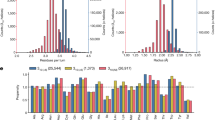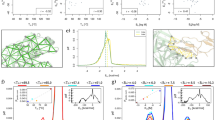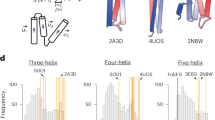Abstract
A recurrent local structural motif is described at the amino terminus of α-helices, that consists of a specific hydrophobic interaction between a residue located before the N-cap, with a residue within the helix (i,i+5 interaction). NMR and CD analysis of designed peptides demonstrate its presence in aqueous solution, its contribution to α-helix stability and its role in defining the α-helix N terminus limit. Comparison between the N-terminal structures of the peptide and those in proteins with the same fingerprint sequence, shows striking similarities. The change in the polypeptide chain direction produced by the motif suggests an important role in protein folding for residues located in polypeptide segments between secondary structure elements.
This is a preview of subscription content, access via your institution
Access options
Subscribe to this journal
Receive 12 print issues and online access
$189.00 per year
only $15.75 per issue
Buy this article
- Purchase on Springer Link
- Instant access to full article PDF
Prices may be subject to local taxes which are calculated during checkout
Similar content being viewed by others
References
Anfinsen, C.B. The kinetics of formation of of native ribonuclease during oxydation of the reduced polypeptide chain. Science 181, 223–230 (1973).
Chreighton, T.E. Protein folding. Biochem. J. 270, 1–16 (1990).
Karplus, M. & Weaver, D.L. Protein folding dynamics. Biopolymers 18, 1421–1437 (1979).
Dill, K.A., Fiebig, K.M. & Chan, H.S. Cooperativity in protein-folding kinetics. Proc. natn. Acad. Sci. U.S.A. 90, 1942–1496, (1993).
Harper, J. & Rose, G.D. Helix stop signals in proteins and peptides: the capping box. Biochemistry 32, 7605–7609 (1993).
Richardson, J.S. & Richardson, D.C. Amino acid preferences for specific locations at the ends of α-helices. Science 240, 1648–1652 (1988).
Dasgupta, S. & Bell, J.A. Design of helix ends. Int. J. Peptide Res. 41, 499–511 (1993).
Seale, J.W., Srinivasan, R. & Rose, G.D. Sequence determinants of the capping-box, a stabilizing motif at the N-termini of α-helices. Prot. Sci. 3, 1741–1745, (1994).
Sippl, M. Calculation of conformational ensembles from potentials of mean force. An approach to the knowledge-based prediction of local structures in globular proteins. J. molec. Biol. 213, 859–883 (1990).
Jiméenez, M.A., Nieto, J.L., Herranz, J., Rico, M. & Santoro, J. 1H NMR and CD evidence of the folding of the isolated ribonuclease 50–61 fragment. FEBS Letts 221, 320–324 (1987).
Wishart, D.S., Sykes, B.D. & Richards, F.M. Relationship between nuclear magnetic resonance chemical shifts and protein secondary structure. J. molec. Biol. 222, 333–344 (1991).
Lyu, P.C., Zhou, H.X., Jelveh, N. Wemmer, D.E. & Kallenbach, N.R. Position-dependent stabilizing effects in α-helices: N-terminal capping in synthetic model peptides. J. Am. chem. Soc. 114, 6560–6562 (1992).
Wüthrich, K. NMR of proteins and nucleic acids. (John Wiley & sons, New York, 1986).
Lyu, P.C., Liff, M.I., Marky, L.A. & Kallenbach, N.R. Side chain contributions to the stability of α-helical structures in peptides. Science 250, 669–673 (1990).
O'Neil, K.T. & DeGrado, W.F. A thermodynamic scale for the helix-forming tendencies of the commonly occurring amino acids. Science 250, 646–650 (1990).
Serrano, L., Neira, J.L., Sancho, J. & Fersht, A.R. Effect of alanine versus glycine in α-helices on protein stability. Nature 356, 453–455 (1992).
Horovitz, A., Matthews, J. & Fersht, A.R. α-helix stability in proteins. II. Factors that influence stability at an internal position. J. molec. Biol. 227, 560–568 (1992).
Blaber, M., Zang, X. & Matthews, B. Structural basis of amino acid α-helix propensity. Science 260, 1637–1640 (1993).
Chakrabartty, T. Kortemme & Baldwin R.L. Large differences in the helix propensities of alanine and glycine. Prot. Sci. 3, 843–847 (1994).
Jiménez, M.A., Muñoz, V., Rico, M. & Serrano, L. Helix stop and start signals in peptides and proteins: The capping box does not necessarily prevent helix elongation. J. molec. Biol. 242, 487–496(1994).
Muñoz, V. & Serrano, L. Elucidating the folding problem of helical peptides using empirical parameters. Nature struct. Biol. 1, 399–409 (1994).
Muñoz, V. & Serrano, L. Elucidating the folding problem of helical peptides using empirical parameters, II: helix macrodipole effects and rational modification of the helical content of natural peptides. J. molec. Biol. 245, 275–296. (1995).
Muñoz, V. & Serrano, L. Elucidating the folding problem of helical peptides using empirical parameters, III: Temperature and pH dependence. J. molec. Biol. 245, 297–308. (1995).
Hobohm, U., Scharf, M., Schneider, R. & Sander, C. Selection of representative protein datasets. Prot. Sci. 1, 409 (1992).
Muñoz, V. & Serrano, L. Intrinsic secondary structure propensities of the amino acids, using statistical phi-psi matrices: comparison with experimental scales. Prot. Struct. Funct. Genet. 20, 301–311 (1994).
Vriend, G. WHATIF: A molecular modeling and drug design program. J. molec. Graph. 8, 52–56 (1990).
Kabsch, W. & Sander, C. Dictionary of protein secondary structure: pattern of recognition of hydrogen-bonded and geometrical features. Biopolymers 22, 2577–2637 (1983).
P. Güntert, W., Braun, K., Wüthrich Improved efficiency of protein structure calculations from NMR using the program DIANA with redundant dihedral angle constraints. J. molec. Biol. 217, 517–530 (1991).
Chen, Y.H., Yang, J.T. & Chow, K.H. Determination of the helix and β form of proteins in aqueous solution by circular dichroism. Biochemistry 13, 3350–3359 (1974).
Bruch, M.D., Dhingra, M.M. & Gierasch, L.M. Side chain backbone hydrogen bonding contributes to helix stability in peptides derived from an α-helical region of carboxypeptidase A Prot. Struct. Func. Genet. 10, 130 (1991).
Author information
Authors and Affiliations
Rights and permissions
About this article
Cite this article
Muñoz, V., Blanco, F. & Serrano, L. The hydrophobic-staple motif and a role for loop-residues in α-helix stability and protein folding. Nat Struct Mol Biol 2, 380–385 (1995). https://doi.org/10.1038/nsb0595-380
Received:
Accepted:
Issue Date:
DOI: https://doi.org/10.1038/nsb0595-380
This article is cited by
-
Evolutionary fine-tuning of residual helix structure in disordered proteins manifests in complex structure and lifetime
Communications Biology (2023)
-
Evolutionary conservation of the intrinsic disorder-based Radical-Induced Cell Death1 hub interactome
Scientific Reports (2019)
-
Mapping side chain interactions at protein helix termini
BMC Bioinformatics (2015)
-
Ionic polypeptides with unusual helical stability
Nature Communications (2011)
-
Amino-acid substitutions in a surface turn modulate protein stability
Nature Structural Biology (1996)



